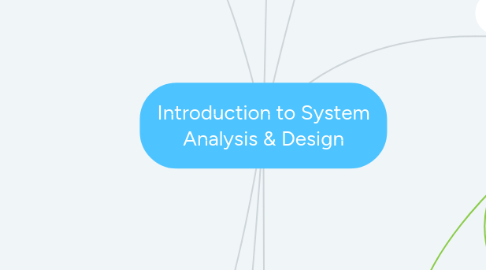
1. Discuss system development approach
2. Explain system development method
2.1. Structured Analysis
2.1.1. A traditional systems development technique that is time tested and easy to understand. Uses a series of phases to plan, analyze, design, implement and support an IS.
2.2. Object Oriented Analysis
2.2.1. A popular technical approach for analyzing, designing an application, system, or business by applying the object-oriented paradigm and visual modeling throughout the development life cycles to foster better stakeholder communication and product quality.
2.3. Agile/Adaptive Method
2.3.1. Refers to an iterative, incremental method of managing the design and build activities of engineering, information technology and other business areas that aim to provide new product or service development in a highly flexible and interactive manner.
3. Explain System Development Life Cycle (SDLC) activities:
3.1. Planning
3.1.1. This is the first phase in the systems development process. It identifies whether or not there is the need for a new system to achieve a business’s strategic objectives
3.2. Analyze
3.2.1. The second phase is where businesses will work on the source of their problem or the need for a change. In the event of a problem, possible solutions are submitted and analyzed to identify the best fit for the ultimate goal(s) of the project.
3.3. Design
3.3.1. The third phase describes, in detail, the necessary specifications, features and operations that will satisfy the functional requirements of the proposed system which will be in place.
3.4. Development
3.4.1. The fourth phase is when the real work begins in particular, when a programmer, network engineer and/or database developer are brought on to do the major work on the project.
3.5. Testing
3.5.1. The fifth phase involves systems integration and system testing (of programs and procedures) normally carried out by a Quality Assurance (QA) professional to determine if the proposed design meets the initial set of business goals.
3.6. Implementation
3.6.1. The sixth phase is when the majority of the code for the program is written. Additionally, this phase involves the actual installation of the newly-developed system.
3.7. Maintenance
3.7.1. The seventh and final phase involves maintenance and regular required updates.
4. Describe various types of life cycle models such as:
4.1. Waterfall model
4.1.1. Represents the system in terms of data and the processes that objects that act upon that data.
4.2. Spiral model
4.2.1. Was suggested in the 1990s by Barry Boehm, a noted software engineering professor. He stated that each iteration, or phase, of the model must have a specific goal that is accepted, rejected, or changed by the user, or client.
4.3. Iterative and incremental development
4.3.1. Develop a system through repeated cycles (iterative) and in smaller portions at a time (incremental), allowing software developers to take advantage of what was learned during development of earlier parts or versions of the system
4.4. Agile or Adaptive Methods
4.4.1. Agile methods attempt to develop a system incrementally, by building a series of prototypes and constantly adjusting them to user requirements
4.4.1.1. Advantages- can allow developers to be much more flexible and responsive
4.4.1.2. Disadvantages- Riskier than more traditional methods. For example, without a detailed set of system requirements, certain features requested by some users might not be consistent with the company’s main business
4.5. Prototyping Model
4.5.1. Prototyping tests system concepts and provides an opportunity to examine input, output, and user interfaces before final decision are made
4.6. Rapid Application Development (RAD)
4.6.1. A team-based technique that speeds up information systems development and produces a functioning information system
4.6.1.1. Advantages- Systems can be developed more quickly with significant cost savings
4.6.1.2. Disadvantages- RAD stresses the mechanics of the system itself and does not emphasize the company’s strategic business needs
4.7. Joint Application Development (JAD)
4.7.1. A JAD team usually meets over a period of days or weeks to analyze the existing system, obtain user input and expectations, and document user requirements for the new system

